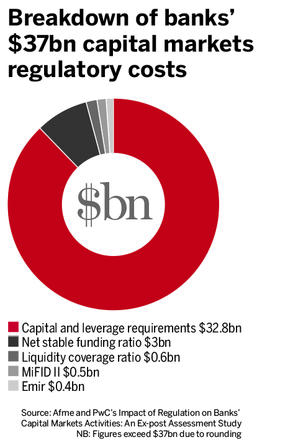Banks spend billions in annual capital markets compliance
The world’s biggest banks collectively spend $37bn on capital markets compliance each year. Danielle Myles reports.
The world’s biggest 13 banks collectively rack up $37bn in capital markets-related regulatory costs each year, according to research by the Association for Financial Markets in Europe (Afme) and PwC. Capital and leverage-related charges are the main culprit, accounting for more than 88% of these regulatory expenses.
The finding is based on 2016 data drawn from banks that account for 70% of capital markets activity. The $37bn figure represents nearly 40% of their total capital markets expenses. Without capital and leverage rules, their annual regulatory expenses would amount to just $4.2bn.
Basel III’s liquidity requirements are the second biggest contributor. The net stable funding ratio generates $3bn of costs each year while the liquidity coverage ratio creates $600m.
In terms of regulatory spend related to trading, the second iteration of the Markets in Financial Instruments Directive (MiFID II) contributes $500m while the European Market Infrastructure Regulation (Emir) contributes $400m.
PwC estimates that regulations were responsible for nearly 40% of the banks’ shrinkage of capital markets assets between 2010 and 2016. Rates, credit, commodities and equities saw the biggest declines.
All data sourced from Afme’s Impact of Regulation on Banks’ Capital Markets Activities: An Ex-post Assessment Study.



